Photo albums from this trip are here.
In August we went to Russia (with a short side trip to Mongolia). This page is a very brief summary of the fourth part of the trip, from the Mongolian border to Lake Baikal and Irkutsk. We intend to return and fill in more details when we find time.
Thursday, 12 August: After again traveling through the night, we arrived at Sukhe Bator around 6:30 AM. The Mongolian authorities came in board and collected our passports and other forms. These were returned in plenty of time to head off for breakfast at 8 a.m.
We left Sukhe Bator around 8:30 a.m. The Russian authorities boarded at Dozorny, the actual border, and collected our documents. They rode the train with us as far as the main border control town of Naushki. We had our passports back by around 10 a.m but remained at Naushki station until after 1 p.m.
After lunch there was a Russian lesson in the bar at 3:15 p.m. then just before 5:00 we stopped at Shuluty for 15 minutes, where most people got off the train for a bus tour. Jean was not feeling well, and stayed behind on the train.
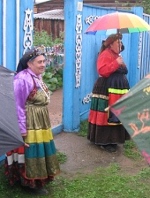
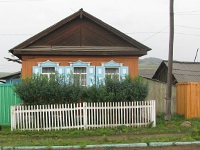 The bus tour guide was a young woman named Anya, who translated very well. We visited the Village of Old Believers (Torbogatai), about a 20 minute drive away. One of the women showed us a traditional style home, consisting of a summer house and a winter house. These were built to suit the extreme difference in climate from summer to winter. They had the coloured shutters and window surrounds we had seen elsewhere. The blue symbolises the sky and hope, and drives away bad spirits because they think it is the sky. Anya also said blue paint is cheap in Russia. I liked the use of bottle tops for decoration. They also had an extremely functional looking vegetable garden.
The bus tour guide was a young woman named Anya, who translated very well. We visited the Village of Old Believers (Torbogatai), about a 20 minute drive away. One of the women showed us a traditional style home, consisting of a summer house and a winter house. These were built to suit the extreme difference in climate from summer to winter. They had the coloured shutters and window surrounds we had seen elsewhere. The blue symbolises the sky and hope, and drives away bad spirits because they think it is the sky. Anya also said blue paint is cheap in Russia. I liked the use of bottle tops for decoration. They also had an extremely functional looking vegetable garden.
The priest in the village showed us their new church. This had an impressive monument in stone, of a book. They also had bells, a gift from the surviving child of someone who had promised to find a way to provide the church with the bells. The Old Believers did not agree with the Orthodox view of the Holy Trinity, counting only Father and Son, so their genuflect was with two fingers rather than three. Catherine the Great exiled them to Siberia. Later the Communists also suppressed religion and removed churches, so the believers had a tough time. We were not allowed to photograph inside the church, but it had impressive iconography. They also had collected what they could of the old books, despite many being lost or destroyed by the previous authorities.
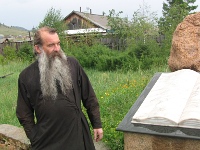
 The church and community had spontaneously built and stocked a heritage museum showing artefacts of their old way of life and their old farm implements. This was an impressive if somewhat jumbled collection. The matriarch of the group explained each section of the museum.
The church and community had spontaneously built and stocked a heritage museum showing artefacts of their old way of life and their old farm implements. This was an impressive if somewhat jumbled collection. The matriarch of the group explained each section of the museum.
We went upstairs to a mezzanine area for a dinner which included traditional foods, plus a generous supply of wine and vodka. The vodka водка was not nearly as nice as that stocked by our train. The villagers performed folk music. Then they enlisted two of our group to demonstrate a play of a wedding performance. They played along very well, with much laughter and applause from all.
The toilet and sanitation facilities in this obviously poor (except in spirit) community were primitive, by contemporary Western standards. We were all carrying hand sanitizer and tissues for just this sort of situation, as it is not uncommon.
We finally had to depart to drive the hour to Ulan Ude with a tour of the city and a stop in the Central Square. It was still light enough to attempt to take a photo of the gigantic head of Lenin in the square. At least he was not hailing a taxi.
The train departed Ulan Ude around 9:50 p.m. For once there is no time change.
Friday, 13 August: When we arose, we were going along the old rail line right beside Lake Baikal. The regular track now bypasses this old, slow, single rail line. We had Lake Baikal on our right hand side, within throwing distance, for hour after hour of travel. Alas, the rainy, misty weather meant we could see little beyond the shoreline. Lake Baikal is the deepest lake in the world and holds 20% of the world’s freshwater. Also known as the ‘Pearl of Siberia’ it is home to a unique breed of freshwater seal and over fifty species of fish including omul which we were served in the dining car for some of our meals.


We had a walk in the rain for about 50 minutes at Polovina (half way) station, a small railway township of wooden buildings, many with the typical vegetable gardens you see around rural Russia. There was even a small store, with colourful Russian products in packets in the window.
We were quite pleased with how well our new GoreTex jackets worked. Nice and warm, no sign of water entry, and the folding hood was handy. The folds over the pockets kept water out when we were putting cameras away. It is pretty unusual for us to even need a jacket except when we travel, so we can not test them at home.
Some time after leaving Polovina before midday, the slow moving train came to a sudden stop. We later learned that a tree had fallen across the track. The crew had to cut it up with a hatchet before we could continue.
During lunch we decided we would not take the afternoon boat trip to Listvyanka, a small Baikal settlement at the base of the hills, where the group were to visit an open air wooden building museum and have an outdoor barbecue for dinner.
As it happened, the boat travelers returned by about five o’clock. They had visited the museum, but the attempt to get the barbecue supplies across the lake had led to the boat taking water. The train crew had to turn back. Doing an outside barbecue under those atrocious conditions was not the best idea. So the dinner was moved back on board the train. It was the barbecue supplies, and tasted just fine.
Eric went to the bar after dinner. Arkady was playing the piano. Later two of our group started singing.
Saturday, 14 August: We parked at Slyudinianka СлюдÑнка overnight, and were still there when we awoke in the morning. The station building looked a lot like a low castle, all in stone. A lot of passengers were waiting on the station for the many trains going through this area. We saw another passenger train with sleeping cars, quite a bit less salubrious than ours.
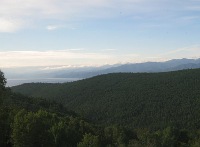
We departed for Irkutsk at 8:30. The day was clear and sunny, and rather belatedly we thought to look out the train windows on the hallway side of the car, discoverÂing that we had views of Lake Baikal on that side. Alas, at that point we were just leaving the lake area, so we caught only glimpses of the lake before it was gone from view. The country here has rolling hills and looks green and lush, with decent sized trees and lots of small villages.
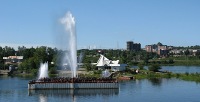 At Irkutsk ИркутÑк we boarded buses for a tour of the city. Lots of interesting parks, squares, statues, cathedrals, as well as a museum in an icebreaker and a variety of housing from older wooden homes (fancy log cabins) to grim communist-era apartment blocks to more modern, cheerful-looking apartments. Our guide Lydia told us the regional population was around 2.5 million. The population density is around 3.5 people people per square kilometre, but most development is along the Trans Siberian Railway line. The climate here to the west is so favourable that they even grow fruits.
At Irkutsk ИркутÑк we boarded buses for a tour of the city. Lots of interesting parks, squares, statues, cathedrals, as well as a museum in an icebreaker and a variety of housing from older wooden homes (fancy log cabins) to grim communist-era apartment blocks to more modern, cheerful-looking apartments. Our guide Lydia told us the regional population was around 2.5 million. The population density is around 3.5 people people per square kilometre, but most development is along the Trans Siberian Railway line. The climate here to the west is so favourable that they even grow fruits.
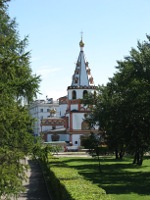 We walked around the park surrounding the Alexander III monument of 1908, commemorating the construction of the Trans Siberian Railway, with the statue looking east, to the new lands of Siberia. This area provided good views of the river, and much of the town. In the same area was the museum, and a large yellow aristocratic house in the neo-classical style. This was near the Gagarin embankment. Here Eric learned to spell ice cream мороженое.
We walked around the park surrounding the Alexander III monument of 1908, commemorating the construction of the Trans Siberian Railway, with the statue looking east, to the new lands of Siberia. This area provided good views of the river, and much of the town. In the same area was the museum, and a large yellow aristocratic house in the neo-classical style. This was near the Gagarin embankment. Here Eric learned to spell ice cream мороженое.
Next we visited the Intourist Hotel, where the more optimist of us tried to get an Internet connection. The business centre on the second floor had three computers available, with connections six roubles a minute. Having Russian keyboards added some excitement to attempts to put in passwords with punctuation. We gather it eventually worked for some people.
Eric had to go to the hotel reception for a WiFi connection for his iPad. 500 roubles for 50 MB! Ouch! The password section of the connection worked. The disconnect did not. Plus we had little time. Eric set email and news feeds downloading; Jean managed to access her Gmail, but we wish we had thought of doing that earlier, as we had to rush to the bus.
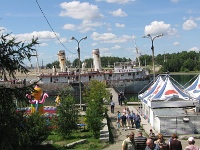 We visited the Icebreaker Angara Ðнгара, once part of the train ferry for the Trans Siberian trains across Lake Baikal. It looked battered, and we imagine the restoration is being done by volunteers.
We visited the Icebreaker Angara Ðнгара, once part of the train ferry for the Trans Siberian trains across Lake Baikal. It looked battered, and we imagine the restoration is being done by volunteers.
 The city of Irkutsk is old, founded in 1661. The city was once mostly wooded buildings, but fear of fires means wood can not longer be used near the historic city centre. We did get taken to see a variety of older wooden homes and even mansions, basically very fancy log cabins. These were often restored and used for things like tourist information centres.
The city of Irkutsk is old, founded in 1661. The city was once mostly wooded buildings, but fear of fires means wood can not longer be used near the historic city centre. We did get taken to see a variety of older wooden homes and even mansions, basically very fancy log cabins. These were often restored and used for things like tourist information centres.
We viewed the Church of the Saviour, and the nearby Church of the Epiphany. Naturally Eric also took photos of the coal fired power station. Then another Eighteen Century square, which if we understood correctly also has markets at times. Lunch was in a fancy city restaurant, with excellent Russian food. The meal concluded with a Bombe Siberia, an ice cream cake. They had attractive grounds, but by then it was 2:40 p.m. and we needed to get away.
Next was a visit to a local market about the size of Sydney’s Paddy’s Markets or Melbourne’s Victoria Markets. We could make little use of the numerous fresh food items, so we went up to the second and third floors of the second set of buildings, and wandered around the electronics and craft shops. We even found the toilets (not in the best of shape). Getting back down was more exciting, as all the escalators led up. We had to locate the stairs (on a Russian map) to exit the place. However we reach the bus with a few minutes to spare before our 4:45 p.m. departure.
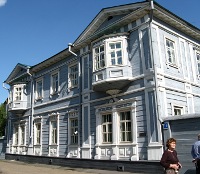 We then visited the mansion of Decemberist Prince Volkonsky, which is dedicated to the memory of the exiled aristocrats who were forced to flee to this remote outpost after the failed revolution of 1825. There (in addition to a tour) we were treated to a private concert featuring excellent piano playing and operatic singing.
We then visited the mansion of Decemberist Prince Volkonsky, which is dedicated to the memory of the exiled aristocrats who were forced to flee to this remote outpost after the failed revolution of 1825. There (in addition to a tour) we were treated to a private concert featuring excellent piano playing and operatic singing.
We were back on board train around 7 p.m. for our departure from Irkutsk and dinner at 8:00.
